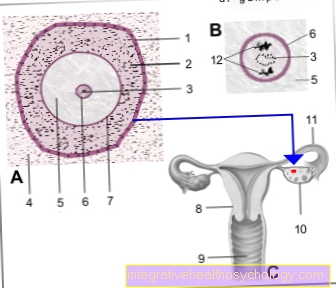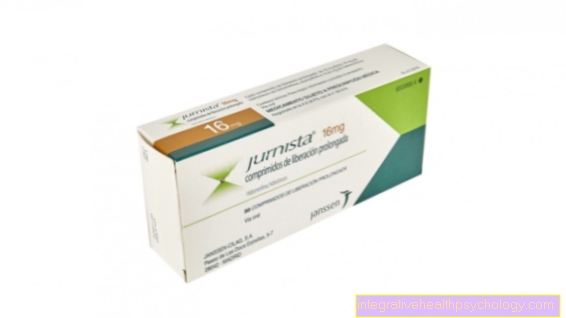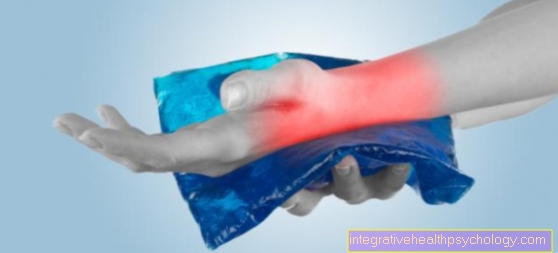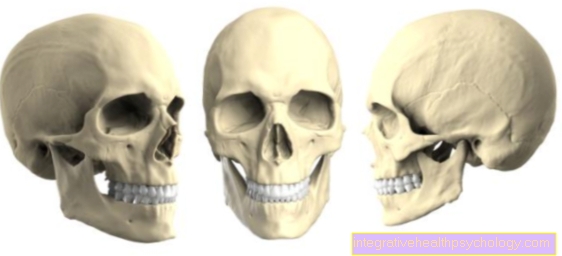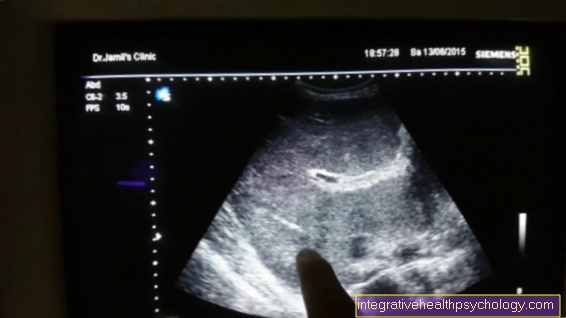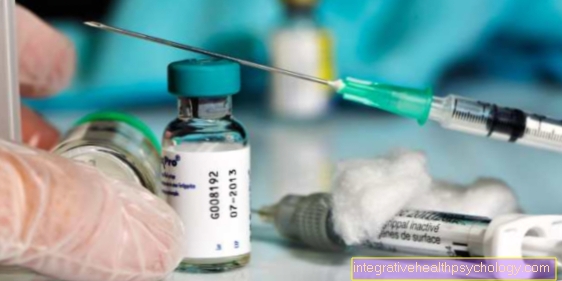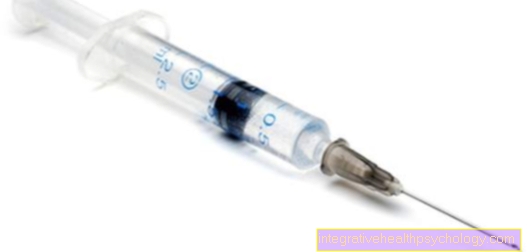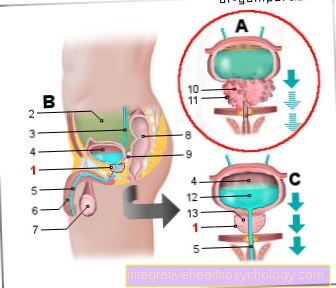The dexamethasone inhibition test
The dexamethasone inhibition test is a test that is done when hypercortisolism is suspected. Hypercortisolism, also known as Cushing's syndrome, describes diseases that are associated with an increased cortisol level. The metabolism of the human body is negatively influenced by the increased cortisol and it becomes unbalanced.
Different symptoms can occur, such as trunk obesity, impaired glucose tolerance, high blood pressure and muscle weakness.

The indications
The dexamethasone inhibition test is carried out if Cushing's syndrome is suspected. This investigation is intended to confirm the suspicion.
Patients who suffer from the following symptoms require further clarification: full moon face, trunk obesity, impaired glucose tolerance, high blood pressure, underfunction of the gonads (erectile dysfunction in men, menstrual cycle disorders in women), muscle weakness and mental disorders. These are the classic symptoms that are caused by this disease. They can occur individually or in combination and should definitely be taken seriously and investigated.
Find out more about the topic here: The symptoms of Cushing's syndrome.
The short test
The test principle is based on a suppression of cortisol. For this the patient takes dexamethasone. Dexamethoson is a synthetically produced glucocorticoid, which has the same effect as cortisol. In order to understand the further principle of the investigation, one should understand the underlying physiology.
In order for the body to produce cortisol, it needs a stimulus. This stimulus comes from the hormone ACTH (adrenocorticotropin), which is formed in the pituitary gland and from there it is released into the bloodstream. The ACTH now reaches the adrenal cortex and stimulates the cells to produce cortisol. As a result, the level of cortisol in the blood increases.
But because too much cortisol is harmful, the body has developed a feedback mechanism. A high cortisol level inhibits the release of ACTH. As a result, less cortisol is produced. But when this level drops again, the ACTH level rises and the cells in the adrenal cortex produce more cortisol again.
For the short test, blood is taken from the patient in the morning and the cortisol level is determined. On the same day, the patient must now take the dexamethasone around midnight. Another blood sample is taken the next day. This is where the cortisol level is determined and assessed. Suppression should occur in healthy people. If this is not the case, the test is positive and further clarification is required. Among other things, the dexamethasone long test should be carried out for this purpose.
The long test
The dexamethasone long test follows the short test. It differs in the duration of the implementation. It usually lasts 3 days and includes multiple doses of dexamethasone.
The test principle is again based on a suppression of cortisol. If this is not the case, it indicates a malfunctioning mechanism.
A suppression that occurs over time suggests a pathology of the central nervous system - i.e. the pituitary gland or the hypothalamus. These are special areas in the brain that regulate this cycle. The ACTH is produced and released by the pituitary gland, among other things. Disturbances in this area affect the entire circulation.
If the suppression does not take place at all, this indicates an independent hormone production. This means that the feedback mechanism that would normally set in with high levels of cortisol is eliminated and the hormone is constantly being developed. This independent production can usually be observed in tumors. Further diagnostics - including imaging procedures - are essential here.
Further information on the subject can be found at: The Cushing Syndrome.
The preparation
There are a few points to consider when preparing. The patient should appear sober to take a blood sample so that the values are not falsified. However, you should drink enough water (no coffee, no other sweet drinks such as orange juice). An increased amount of fluid makes it easier to draw blood.
In addition, some foods shouldn't be skewed. However, these should be mentioned in the scheme that you receive from your doctor. This scheme explains the individual points of the test again exactly and tells you the times for taking the dexamethasone.
The sequence
If the indication has been made, the dexamethasone inhibition test should be prepared. The attending physician should explain and explain to you the reasons for performing the test.
First the dexamethasone short test is carried out. For this purpose, blood is taken from the patient at 8 a.m. and the amount of cortisol is determined. On the same day, the patient should take the dexamethasone at 11 p.m. and have another blood drawn at 8 a.m. the next morning. Depending on the result, the long-term test is then carried out. The course of the long-term test is different or depends on the laboratory that evaluates the test. For this, however, there are special schemes that the treating doctor will give you.
After evaluating the findings, if the test result is positive, the further course should be discussed. Imaging is usually done to rule out tumorous changes.
The evaluation
First of all, you should know that a positive result does not necessarily prove Cushing's syndrome. For example, some medications (anti-epileptic drugs) can affect the result. A lot of stress or mental illness, such as depression, also have an impact on the cortisol level. Additional tests can be carried out as a supplement to finally confirm the diagnosis.
When performing the short test, the cortisol level should drop in a healthy person after the administration of dexamethasone. If this is not the case, there is very likely Cushing's syndrome, which should be further clarified using differential diagnosis. A distinction can be made between primary and secondary Cushing's syndrome.
Primary Cushing's syndrome is caused by a tumorous change in the adrenal cortex. Here, further diagnostics should be carried out using imaging methods (ultrasound, MRT). Secondary Cushing's syndrome is caused by a disorder of the pituitary gland or hypothalamus. Here, too, tumorous changes, such as a pituitary adenoma. In this case, further imaging is also recommended.
Find out all about the topic here: The Cushing Syndrome.
The risks
Risks with a dexamethasone test are not known. Hypersensitivity to the active ingredient can lead to allergic reactions.
What are the alternatives?
Alternative test methods are available - such as a cortisol determination in a 24-hour urine collection, a so-called CRH test and an insulin hypoglycaemia test. They should best be carried out in combination in order to increase the informative value.
Also read the article: The Cushing Test.
Dexamethasone inhibition test in animals
The dexamethasone test can also be used in animals to confirm suspicion of Cushing's syndrome.
There are two ways of doing this test in dogs - you can give the dog a low dose of dexamethasone (low dose) or a high dose (high dose). A high dose version allows the differentiation of Cushing's syndrome. Depending on the cause, a distinction can be made between primary and secondary Cushing's syndrome. In primary Cushing, the cause of the disease lies in the adrenal cortex. This produces an excessive amount of cortisol, even though the level is already too high. Tumor changes can be the reason for this. In secondary Cushing's syndrome, the pathology is in the pituitary or hypothalamus. These are areas in the brain that regulate hormone production and circulation.
With a cat, the low-dose version is used. A distinction between primary and secondary Cushing's syndrome is usually not necessary, since tumorous changes in the adrenal cortex are almost non-existent.
Find out more about this topic here: Cushing's Syndrome in Dogs.
The costs
Since there is a medical indication for a dexamathasone inhibition test to be carried out, the costs should be covered by the health insurance company.
In veterinary medicine, you usually have to bear the costs of the test yourself. They are between 150 and 200 euros.



